How to Make Nutritious and Cost-Effective Rabbit Pellets
Feed is a key part of rabbit farming, accounting for about 75% of total production costs. While store-bought feed are convenient, they're often expensive, may contain hidden risks, and are hard to adjust for different growth stages. Making your own pellets lets you control nutrition, cut costs, and provide a safer, healthier diet for your rabbits.
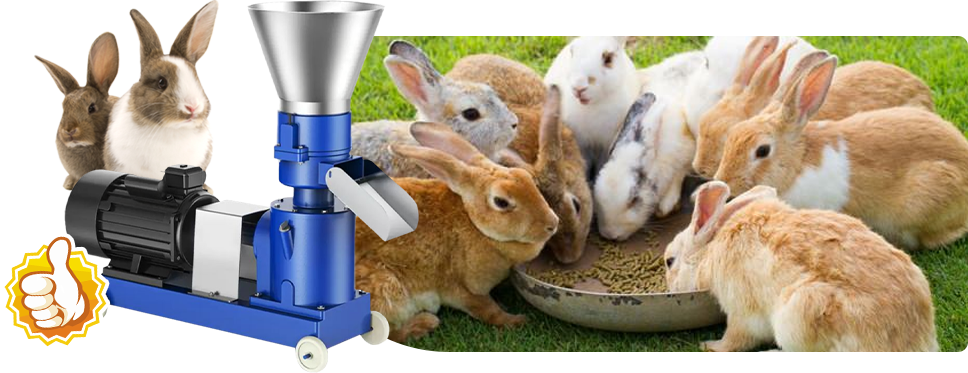
Why Make Your Own Rabbit Feed?
Many rabbit owners choose commercial feed for convenience. But have you ever thought about the hidden risks behind it? If you want your rabbits to stay healthier and lower your feeding costs, making your own rabbit feed could be a smart move.
The Risks of Store-Bought Feed
Many commercial feeds use preservatives and additives to last longer and taste better.
Over time, these can upset a rabbit's digestion and overall health. Since commercial feeds have fixed formulas, they're hard to adjust for rabbits of different ages or conditions, leading to possible overfeeding or nutritional gaps.
In the long run, regularly buying high-quality feed can become a significant cost, especially when raising many rabbits.

Advantages of Making Your Own Rabbit Feed
-
Save Costs and Stay Flexible
Homemade rabbit food pellets use common ingredients and allow bulk purchasing, cutting feed costs by at least 55% compared to store-bought options. -
Control Ingredients for Safer Feeding
You can choose clean, fresh materials and avoid excessive additives, helping rabbits stay healthier with fewer digestive problems. -
Adjust Nutrition as Needed
Different life stages require different nutrition. Homemade feed lets you adjust protein, fiber, and energy levels to match your rabbits' growth needs. -
Diversify the Diet and Reduce Picky Eating
Mixing different hays and vegetables improves appetite, reduces picky eating, and ensures a more balanced intake of essential nutrients. -
Easier Health Monitoring
By observing your rabbits' eating habits and health changes, you can quickly adjust their diet to prevent problems before they start.
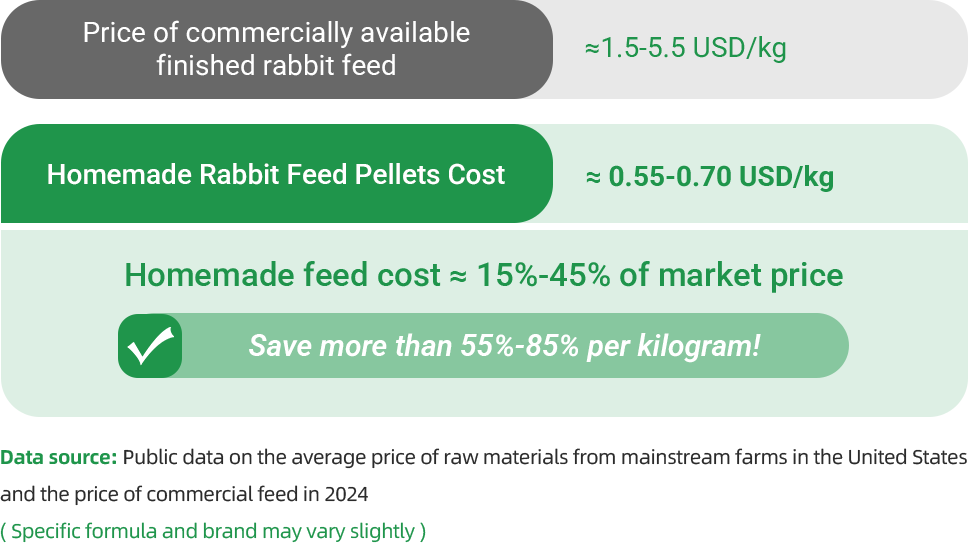
Basic Rabbit Nutrition You Should Know
Understanding what to feed rabbits is key to successful homemade pellet making. Even if it's your first time, following the essentials below will help you create safe and nutritious feed.
Understanding a Rabbit's Diet Structure
A rabbit's diet has a very specific structure, which can be easily visualized as a pyramid:
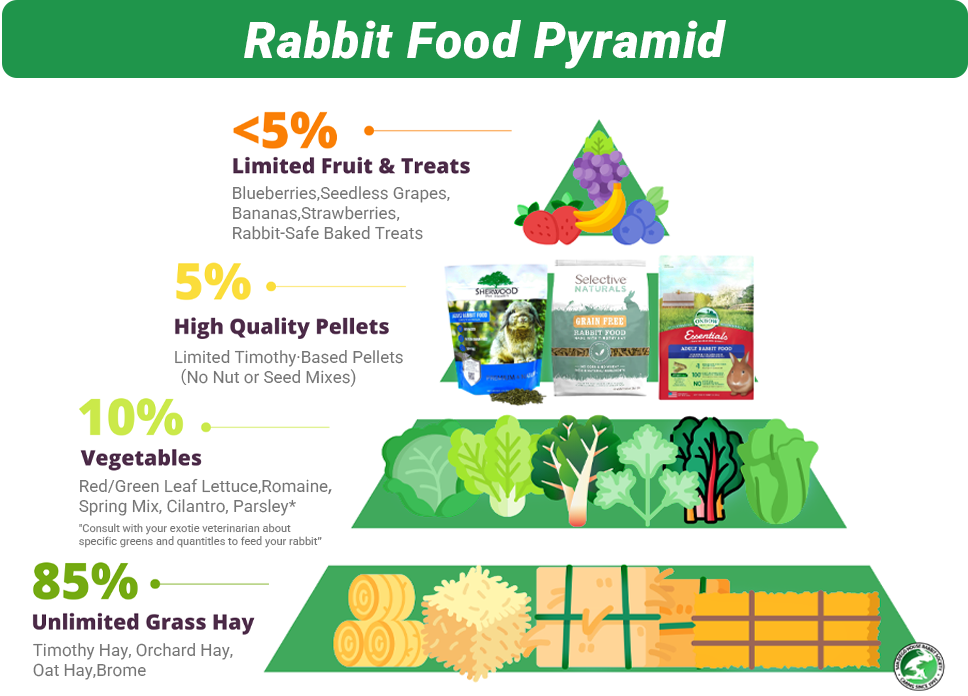
Nutritional Needs by Growth Stage (Reference Values)
| Nutrient | Young Rabbits | Growers | Breeders |
| Crude Protein (%) | 16–18 | 15–16 | 17–18 |
| Crude Fiber (%) | 13–16 | 14–18 | 15–20 |
| Crude Fat (%) | 2–4 | 2–3 | 2–4 |
| Metabolizable Energy (kcal/kg) | 2400–2600 | 2400–2500 | 2500–2600 |
Note: Protein and energy intake should be adjusted appropriately during weaning, illness, and breeding periods. Fixed feeding formulas are not suitable for all stages.
Quick Reference Table for Common Feed Ingredients
Always adjust feed formulas for young rabbits, pregnant does, and sick rabbits who may require more protein and energy.
| Ingredient | Crude Protein (%) | Crude Fiber (%) | Crude Fat (%) | Notes |
| Alfalfa meal | 18–20 | 25–30 | 1.5–2 | High protein and fiber; top forage choice |
| Ryegrass meal | 12–16 | 25–30 | 1–1.5 | High fiber, moderate palatability |
| Cornmeal | 7–9 | 2–3 | 3–4 | High energy, low protein |
| Wheat bran | 14–16 | 8–12 | 3–5 | High protein; aids digestion |
| Soybean meal | 42–48 | 5–7 | 1–2 | Very high protein; essential ingredient |
| Rapeseed meal | 32–36 | 11–15 | 2–3 | High protein; use in moderation |
| Cottonseed meal | 35–40 | 10–12 | 5–7 | High protein; low-cost; must be detoxified |
| Straw meal | 3–4 | 30–40 | 1 | Fiber supplement; low energy |
| Rice husk meal | 2–3 | 35–45 | 0.5 | Very high fiber; use sparingly |
| Dried carrot powder | 7–9 | 8–10 | 0.5–1 | Rich in vitamin A |
| Sweet potato meal | 3–4 | 2–3 | 0.5 | High energy; good source of vitamins |
| Brewer's yeast powder | 40–45 | 5–6 | 2–3 | High protein; rich in B vitamins |

Nutrition data source: Feedipedia: Animal feed resources information system.
Ingredients to Avoid
Some foods are toxic or harmful to rabbits. Never include the following in homemade rabbit food:
- Onions, garlic, leeks: Toxic; damaged blood cells.
- Potatoes, tomato leaves/stems: Cause diarrhea or poisoning.
- Beans and seeds: Lead to gas, bloating, or blockages.
- Chocolate, coffee, tea: Harmful to the nervous system.
- Processed snacks: Too much sugar and salt; damaged organs.
Recommended Feed Formulas for Different Stages
When selecting ingredients for homemade rabbit feed, it's important to first understand what can rabbits eat safely. A healthy rabbit diet includes high-fiber hay, leafy greens, and nutritionally balanced pellets. Below are suggested rabbit feed formulas tailored to each stage:
Young Rabbits (Weaning to 90 Days)
- Formula 1:
Cornmeal 40%, Wheat bran 20%, Rice bran 10%, Soybean meal 11%, Fish meal 7%, Bone meal 3%, Salt 0.5%, Trace mineral premix
- Formula 2:
Cornmeal 40%, Sorghum 10%, Bean cake 10%, Rice powder 10%, Fish meal 6%, Bone meal 3%, Salt 1%, Trace mineral mix 1%
- Formula 3:
Cornmeal 45%, Wheat flour 25%, Soybean meal 15%, Wheat bran 4%, Fish meal 7%, Bone meal 3%, Salt and mineral mix 0.5% each
Grower (90 Days to Market)
- Formula 1:
Cornmeal 50%, Wheat bran 20%, Rice bran 5%, Soybean meal 15%, Fish meal 5%, Bone meal 4%, Salt 0.5%, Trace mineral premix
- Formula 2:
Cornmeal 45%, Sorghum 10%, Bean cake 10%, Wheat bran 10%, Rice bran 10%, Fish meal 10%, Bone meal 3%, Salt 1%, Vitamin & mineral mix
- Formula 3:
Cornmeal 47%, Wheat flour 20%, Soybean meal 10%, Wheat bran 10%, Fish meal 5%, Bone meal 2%, Vegetables 5%, Salt and mineral mix 0.5%
Breeding Rabbits (Mature Bucks & Does)
- Formula 1:
Cornmeal 50%, Wheat bran 20%, Rice bran 10%, Soybean meal 15%, Fish meal 2%, Bone meal 2%, Salt 0.5%, Mineral mix
- Formula 2:
Cornmeal 60%, Soybean meal 10%, Peanut cake 9%, Rice bran 10%, Fish meal 10%, Bone meal 1%, Multivitamin 5g, Zinc sulfate 10g, Copper sulfate 15g
- Formula 3:
Cornmeal 40%, Sorghum 10%, Wheat bran 10%, Rice bran 15%, Fresh fish meal 10%, Salt 1%, Bone meal 4%
How to Make Rabbit Feed Pellets
Compared to loose feed, pelleted feed offers balanced nutrition, better palatability, less waste from picky eating, and easier storage and transport. Making your own rabbit food pellets lets you control the nutrition and effectively reduce farming costs.
Equipment Needed
| Equipment | Purpose / Notes |
| Digital scale, mixing containers | For accurate ingredient measurement |
| Grinder | Ensures proper particle size |
| Mixer (optional) | Can be done by hand for small batches |
| Mixing bin and shovel | Manual mixing if no machine is used |
| Meat grinder or pellet machine | At least one machine is required to form pellets |
| Drying rack / ventilated area | Good airflow is sufficient |
| Dryer (optional) | Useful in humid conditions or for large batches |
| Storage bins or bags | For moisture-proof storage |
Process Overview
1. Prepare Ingredients
Choose suitable ingredients based on your rabbits' age and growth stage.
2. Grind and Mix the Ingredients
- Grind all solid materials (e.g., corn, hay, bean cakes) into small particles about 1–2 mm for better digestion.
- Mix the ground materials thoroughly according to the selected formula.
3. Add Water and Stir
Gradually add water to the dry mix and stir evenly.
Tip: The right moisture level is when the mix holds its shape when squeezed but doesn't drip between your fingers.
4. Form the Pellets
Feed the damp mixture into a meat grinder or pellet machine to form cylindrical pellets.
5. Dry and Store
- Spread the pellets in a well-ventilated area to air-dry or use a drying machine.
- Dry until moisture content drops below 12% to prevent mold.
Once the pellets are ready, store them properly to ensure freshness and support healthy rabbit feeding routines.
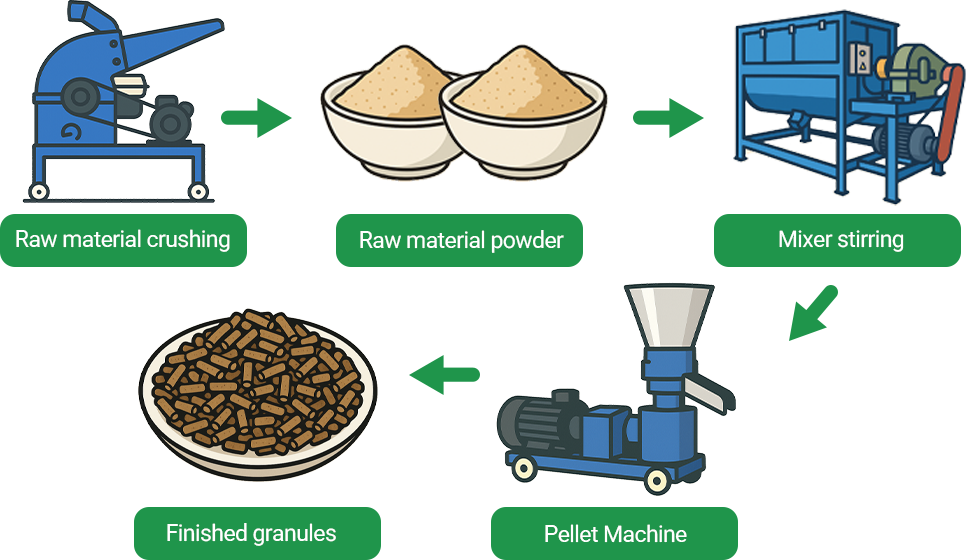
If you'd like help choose the right pellet machine or want to learn more about our products, we're here to offer expert advice and support for efficient rabbit feed production.
Recommended Pellet Sizes
| Rabbit Stage | Recommended Pellet Size |
| Young rabbits (Weaning to 3 months) | 2–3 mm |
| Grower (3–6 months) | 3–4 mm |
| Breeding Rabbit (6 months and up) | 4–5 mm |
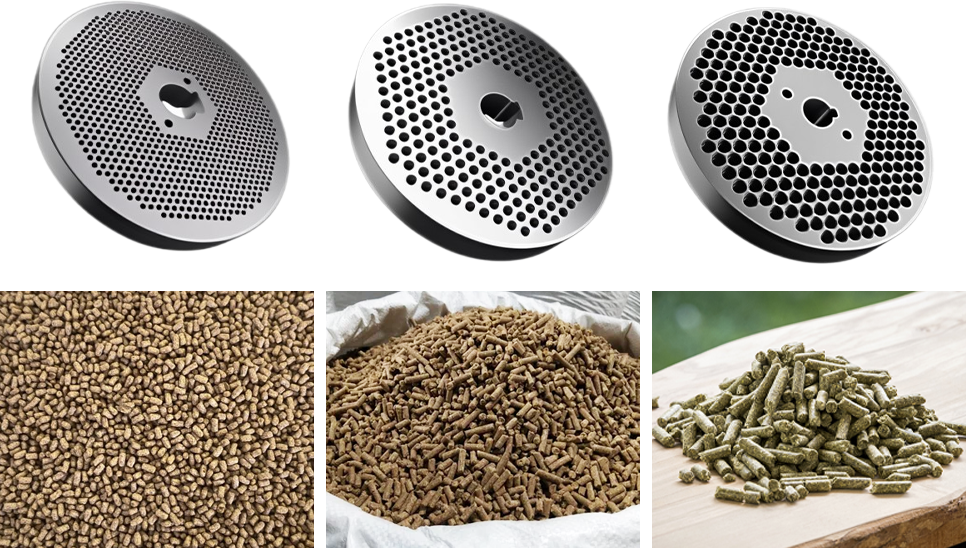
Common Problems with Homemade Rabbit Feed Pellets
Why are my pellets loose or crumbly?
Usually too dry or lacking starch. Try adding more cornmeal or soybean meals, and don't overuse hay. The mix should clump when squeezed but not drip.
Why does the pellet machine jam?
The mix may be too wet or too fibrous. Make sure the ingredients are finely ground and feed in small, steady amounts.
Why do pellets break after drying?
Fast drying or poor binding is the cause. Add cornmeal, wheat bran, or a bit of oil. Air dry or use low heat to keep pellets firm.
My rabbits won't eat the new pellets-what should I do?
Transition slowly: start with 30% new, 70% old feed over 7–10 days. Adding carrot powder or apple pulp can improve aroma and appeal.
How long can I store homemade pellets?
If fully dried and stored in a cool, dry place, they last 1–2 months. In humid areas, use within 1 month for the best quality.
Homemade rabbit feed pellets are a smart way to meet your rabbits' nutritional needs, control feeding costs, and improve daily rabbit care.
If you're looking to improve feed production efficiency or need pelletizing solutions, feel free to contact us. We offer professional equipment recommendations and customized solutions to help make your rabbit farming more efficient and cost-effective.

 Online Contact
Online Contact Send Message
Send Message
Need Some Help?
Contact us quickly and we will reply you within 24 hours. We will not disclose your information.